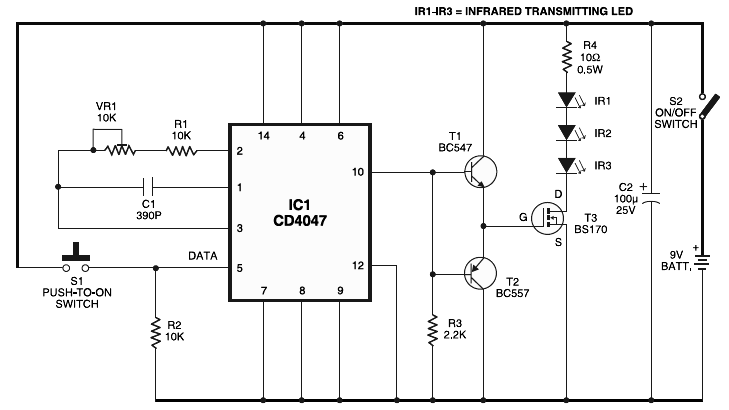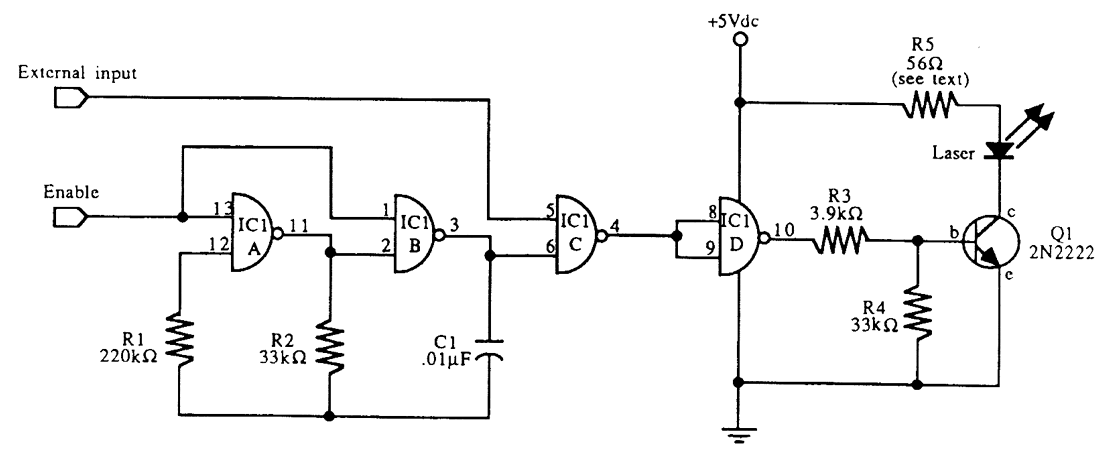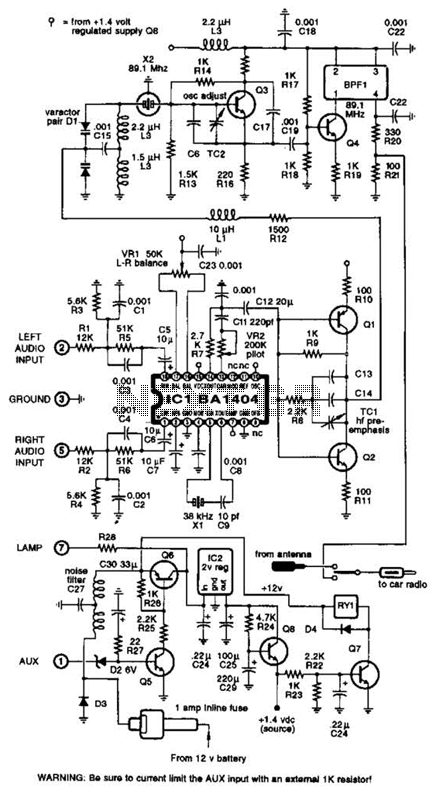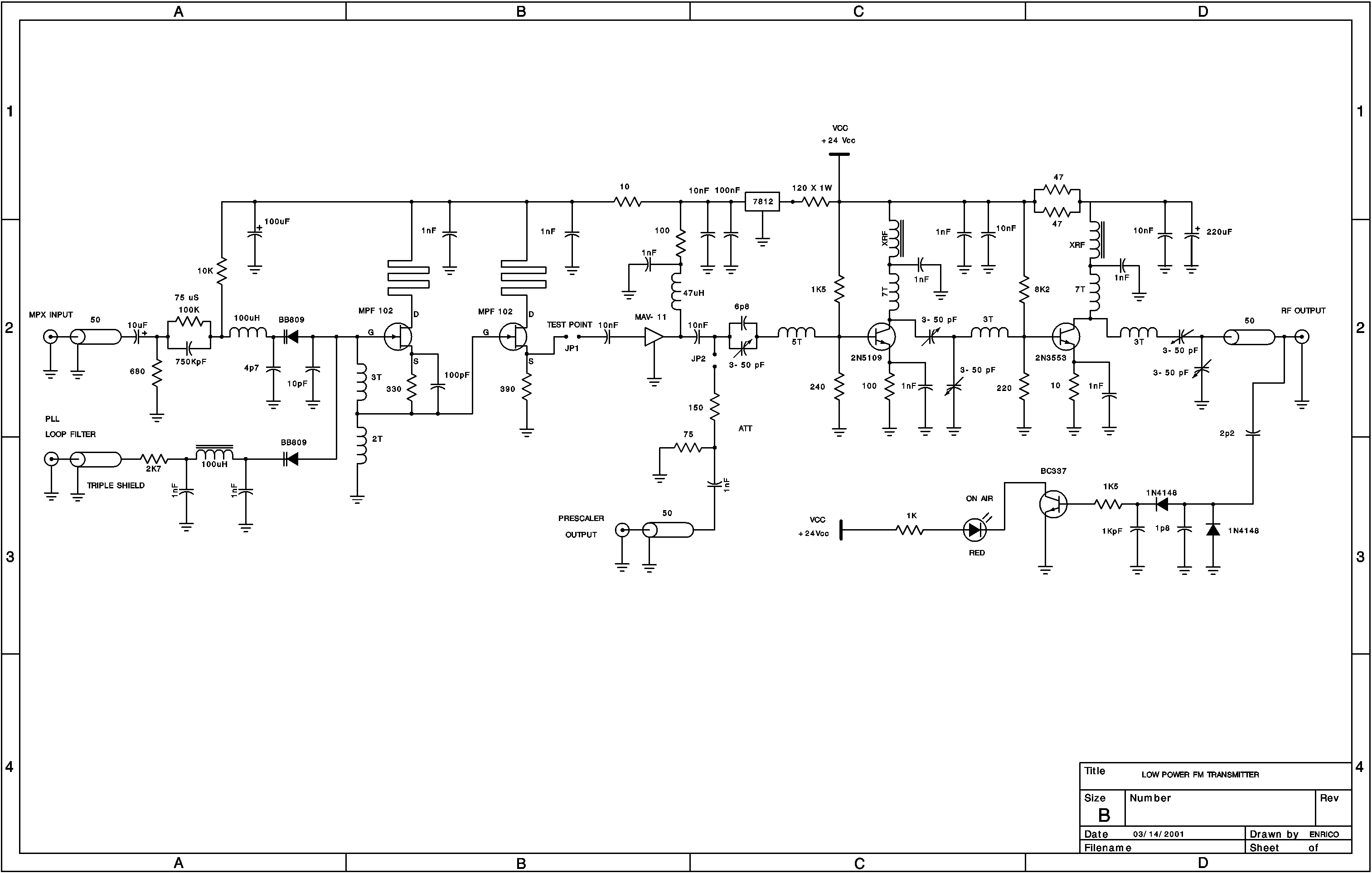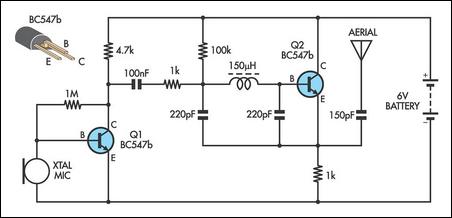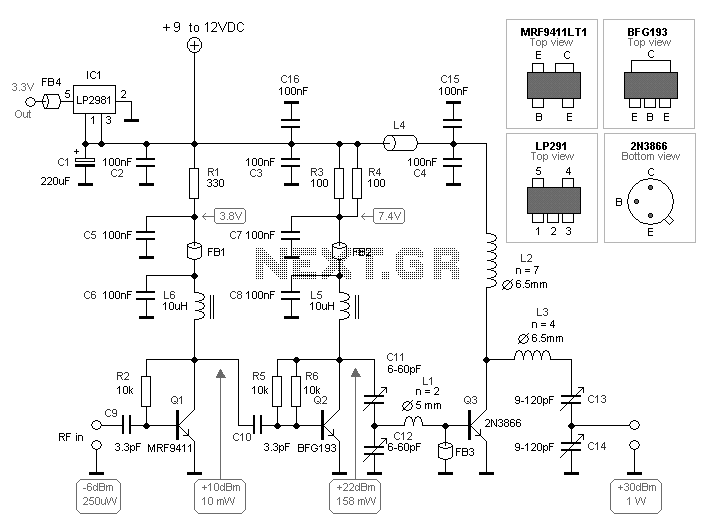
Medium-Power FM Transmitter
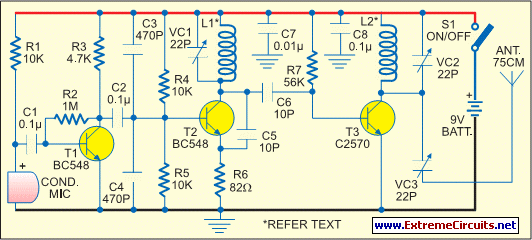
The range of this FM transmitter is approximately 100 meters when powered by a 9V DC supply. The circuit consists of three stages. The first stage is a microphone preamplifier constructed using a BC548 transistor. The second stage is a VHF oscillator also utilizing a BC548 transistor. Although BC series transistors are typically employed in low-frequency applications, they perform adequately in RF stages as oscillators. The third stage is a class-A tuned amplifier that enhances signals from the oscillator. The inclusion of an additional RF amplifier extends the transmitter's range. Coil L1 consists of four turns of 20 SWG enameled copper wire wound to a length of 1.5 cm with a 4 mm diameter air core. Coil L2 is made up of six turns of 20 SWG enameled copper wire wound on a 4 mm diameter air core. An antenna of 75 cm in length is recommended for optimal range. For the best performance, a sensitive receiver should be used. VC1 serves as a frequency-adjusting trimpot, while VC2 should be fine-tuned to achieve maximum range. The transmitter unit operates on a 9V PP3 battery and can be paired with a standard FM receiver kit to create a walkie-talkie system.
The FM transmitter circuit operates effectively within a range of approximately 100 meters, making it suitable for short-range communication applications. The design incorporates three distinct stages, each serving a specific function to ensure optimal signal transmission.
The first stage, a microphone preamplifier, is vital for capturing audio signals. The choice of the BC548 transistor facilitates amplification of low-level audio signals, preparing them for further processing. This stage is crucial for ensuring that the audio input is adequately boosted before being sent to the next stage.
In the second stage, the VHF oscillator, the circuit generates a radio frequency signal. The use of a BC548 transistor in this role demonstrates its versatility, as it can perform effectively in RF applications despite its common association with low-frequency circuits. This oscillator is responsible for modulating the audio signal onto a carrier wave, which is essential for FM transmission.
The third stage features a class-A tuned amplifier designed to enhance the strength of the RF signal generated by the oscillator. This amplification is critical for extending the transmission range, allowing the signal to travel further distances. The additional RF amplifier significantly contributes to the overall performance of the transmitter.
Coils L1 and L2 are integral components of the circuit, providing the necessary inductance for tuning and signal amplification. The construction of these coils using 20 SWG enameled copper wire ensures efficient signal handling. Coil L1, with its four turns, is designed for initial signal processing, while Coil L2, with six turns, further refines the signal for transmission.
The antenna plays a pivotal role in the effective broadcasting of the FM signal. A 75 cm long wire is specified to maximize the range, allowing the transmitter to reach its full potential. The performance of the transmitter can be significantly enhanced when paired with a sensitive receiver, which is capable of picking up weak signals.
To facilitate fine-tuning of the transmitter, VC1 is employed as a frequency-adjusting trimpot, allowing for minor adjustments to the operational frequency. VC2 is another variable capacitor that should be calibrated to achieve the best transmission range, ensuring that the transmitter operates efficiently within its designated frequency band.
Powering the entire circuit is a 9V PP3 battery, providing a stable and reliable source of energy for the transmitter's operation. This compact power supply makes the circuit suitable for portable applications, such as creating a walkie-talkie system when combined with a compatible FM receiver kit. Overall, this FM transmitter circuit design offers a practical solution for short-range wireless communication.The range of this FM transmitter is around 100 meters at 9V DC supply. The circuit comprises three stages. The first stage is a microphone preamplifier built around BC548 transistor. The next stage is a VHF oscillator wired around another BC548. (BC series transistors are generally used in low-frequency stages. But these also work fine in RF stage s as oscillator. ) The third stage is a class-A tuned amplifier that boosts signals from the oscillator. Use of the additional RF amplifier increases the range of the transmitter. Coil L1 comprises four turns of 20SWG enameled copper wire wound to 1. 5cm length of a 4mm dia. air core. Coil L2 comprises six turns of 20SWG enameled copper wire wound on a 4mm dia. air core. Use a 75cm long wire as the antenna. For the maximum range, use a sensitive receiver. VC1 is a frequency-adjusting trimpot. VC2 should be adjusted for the maximum range. The transmitter unit is powered by a 9V PP3 battery. It can be combined with a readily available FM receiver kit to make a walkie-talkie set. 🔗 External reference
The FM transmitter circuit operates effectively within a range of approximately 100 meters, making it suitable for short-range communication applications. The design incorporates three distinct stages, each serving a specific function to ensure optimal signal transmission.
The first stage, a microphone preamplifier, is vital for capturing audio signals. The choice of the BC548 transistor facilitates amplification of low-level audio signals, preparing them for further processing. This stage is crucial for ensuring that the audio input is adequately boosted before being sent to the next stage.
In the second stage, the VHF oscillator, the circuit generates a radio frequency signal. The use of a BC548 transistor in this role demonstrates its versatility, as it can perform effectively in RF applications despite its common association with low-frequency circuits. This oscillator is responsible for modulating the audio signal onto a carrier wave, which is essential for FM transmission.
The third stage features a class-A tuned amplifier designed to enhance the strength of the RF signal generated by the oscillator. This amplification is critical for extending the transmission range, allowing the signal to travel further distances. The additional RF amplifier significantly contributes to the overall performance of the transmitter.
Coils L1 and L2 are integral components of the circuit, providing the necessary inductance for tuning and signal amplification. The construction of these coils using 20 SWG enameled copper wire ensures efficient signal handling. Coil L1, with its four turns, is designed for initial signal processing, while Coil L2, with six turns, further refines the signal for transmission.
The antenna plays a pivotal role in the effective broadcasting of the FM signal. A 75 cm long wire is specified to maximize the range, allowing the transmitter to reach its full potential. The performance of the transmitter can be significantly enhanced when paired with a sensitive receiver, which is capable of picking up weak signals.
To facilitate fine-tuning of the transmitter, VC1 is employed as a frequency-adjusting trimpot, allowing for minor adjustments to the operational frequency. VC2 is another variable capacitor that should be calibrated to achieve the best transmission range, ensuring that the transmitter operates efficiently within its designated frequency band.
Powering the entire circuit is a 9V PP3 battery, providing a stable and reliable source of energy for the transmitter's operation. This compact power supply makes the circuit suitable for portable applications, such as creating a walkie-talkie system when combined with a compatible FM receiver kit. Overall, this FM transmitter circuit design offers a practical solution for short-range wireless communication.The range of this FM transmitter is around 100 meters at 9V DC supply. The circuit comprises three stages. The first stage is a microphone preamplifier built around BC548 transistor. The next stage is a VHF oscillator wired around another BC548. (BC series transistors are generally used in low-frequency stages. But these also work fine in RF stage s as oscillator. ) The third stage is a class-A tuned amplifier that boosts signals from the oscillator. Use of the additional RF amplifier increases the range of the transmitter. Coil L1 comprises four turns of 20SWG enameled copper wire wound to 1. 5cm length of a 4mm dia. air core. Coil L2 comprises six turns of 20SWG enameled copper wire wound on a 4mm dia. air core. Use a 75cm long wire as the antenna. For the maximum range, use a sensitive receiver. VC1 is a frequency-adjusting trimpot. VC2 should be adjusted for the maximum range. The transmitter unit is powered by a 9V PP3 battery. It can be combined with a readily available FM receiver kit to make a walkie-talkie set. 🔗 External reference
